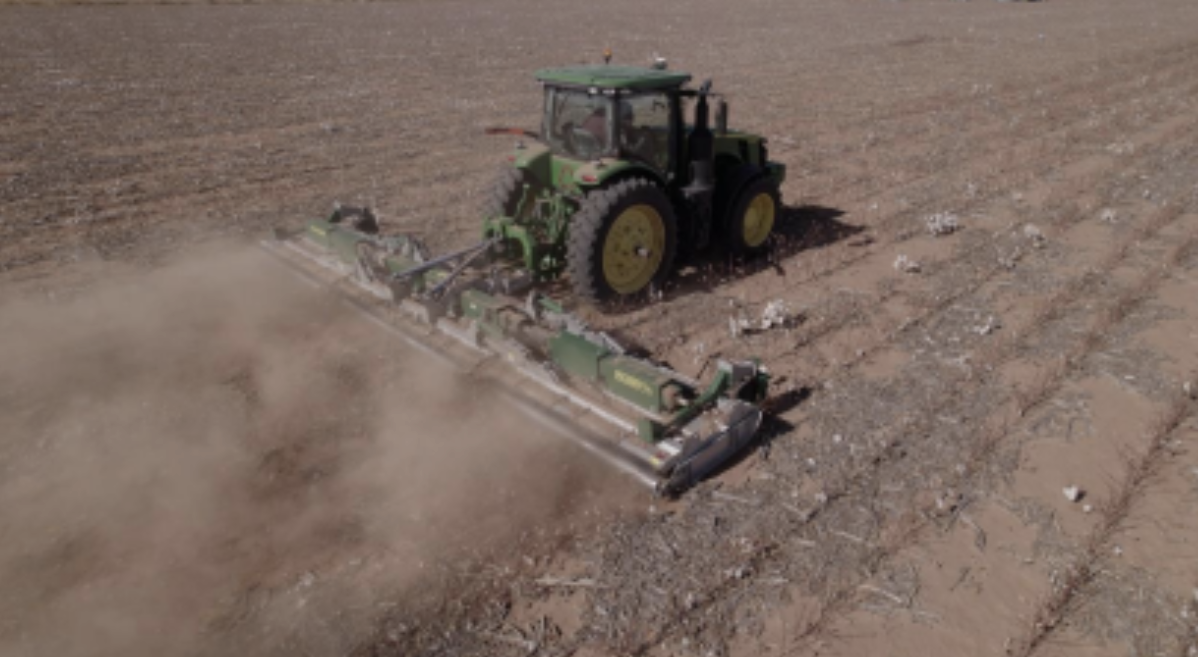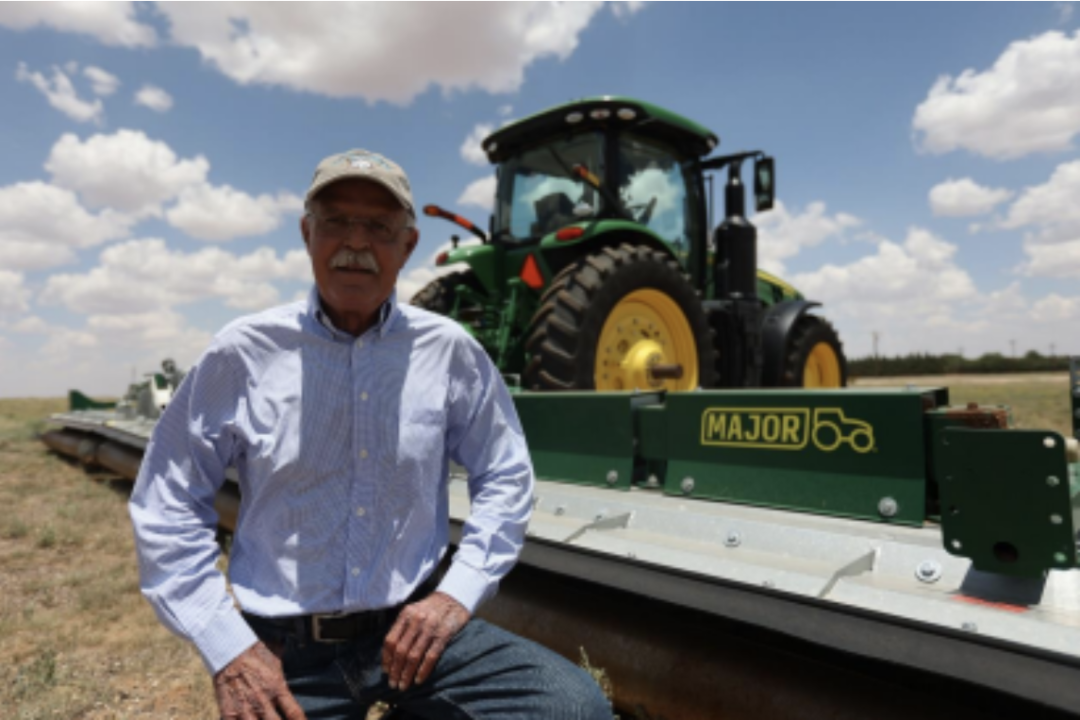Texas cotton producer Sam Stanley approaches farming with keen calculation. Being inefficient is not an option in a region where water is a limited natural resource and Mother Nature’s hands often deliver stalk-stripping winds and hail that tests the patience of anyone making a living off the land.
Stanley is an astute businessman. He manages a multi-generational farm near Levelland, Texas, and loves kicking the tires on new farming technologies. However, he is careful to always adhere to his own advice which he often offers younger farmers.
“Look at what you’re doing on your operation every year, and then ask yourself if you’re doing it because it is better, or because that’s just the way you’ve always done it,” says Stanley. “That’s what led me to no-till. I haven’t plowed any fields on my farms in 14 years.”
Each season he puts one-third less time on each of his three tractors than he did when he was making multiple trips across his 2,350 acre operation ripping up soil.
Stanley experimented with various forms of minimum tillage but after installing sub-surface drip irrigation tape across his farms in 2003, plowing became a thing of the past because the disturbed soil was preventing water from reaching up to the plant’s root zone.
“It has taken 20 years for sub-surface drip irrigation to become common around here,” said Stanley. “I switched from 40-inch to 30-inch row spacing. Now my rows are 5 inches closer to the tape, so I lose no irrigation water to evaporation, so I feel like I’m turning every drop of water into profit-making yield.”
With over 4,400 miles of twelve-inch tape buried between rows across his farms, he spoon feeds nutrients to growing cotton plants with remarkable efficiency. Some of soils across his operation have minerals, like manganese and calcium that sometimes clog emitters. To alleviate that problem, once a year he runs an acidic mixture through the tape that lowers the pH and helps keep them clean and flowing efficiently.
The sub-surface tape is sectioned into manageable zones, with one zone encompassing 5-17 acres. Inputs can be varied per zone but not over different soil types.
“On my high boy sprayer, I use prescriptions generated through infrared satellite maps downloaded from the John Deere operations center,” says Stanley. “I can use my harvest maps to create a prescription when I plant the following season.”

30ft Major Cyclone Rotary Cutter mounted on John Deere 8245R
Equipment
There is a defined thought process Stanley goes through before making any equipment purchase.
“I always want to know if it’s going to make me more productive or lower my input costs, and if so, how much,” said Stanley. I also try to pencil out how long it will take me to recover that capital expense.”
Stanley is adamant about reviewing new farming technologies. He understands they change quickly and feels like if he doesn’t stay current with new releases, he might get left behind.
“I try to spend money on purchasing new equipment rather than repairing old,” said Stanley. “That’s been my philosophy for a long time. On average, it helps me eliminate production downtime. Few things are more frustrating than standing idle in a field with a broken piece of equipment.”
He grows a few acres of extra long staple (ELS) cotton, but most of his cotton acreage is planted to Deltapine and NexGen varieties bred for shorter plant structure that he strips with the three John Deere 690s he owns in partnership with his cousin.
“Since I’ve been using the no-till system, I leave my cotton stalks standing through the winter. We’re in the maintenance phase of the boll weevil eradication program (BWEP) and our winters are so cold, it’s probably been ten years since the BWEP has had to spray,” said Stanley.
When planting season begins, he cuts down the previous year’s stalks and plants right into the same rows. Rotary cutters have been a staple piece of equipment on the family farm, but just prior to the 2020 season, Stanley’s dealer, Hurst Equipment Company, received a new rotary cutter that caught his attention.
“A friend of mine who farms just east of Lubbock bought one and ran it over several of his acres after harvest. I paid him a visit, watched it operate and was impressed,” said Stanley. “As I mentioned, anything I decide to purchase has got to improve, add value to or lower my operational costs before I get excited about it. The MJ30-920 Cyclone did all three.”
Manufactured by Major Equipment Int. Ltd, the Cyclone Stanley selected cuts a 30-foot wide swath, allowing him to take down ten rows with each pass.
“It speeds up the process of stalk cutting tremendously,” said Stanley. “I immediately saw savings from a reduction in fuel use and fewer hours on my tractor. I can cover 20% more acreage in one day with one less tractor and driver. That’s a clear economic savings.”
One of those advantages Stanley also spotted quickly is the consistent mulch pattern the Cyclone leaves behind. The wind erosion problems with which Stanley has to deal, are somewhat mitigated by the even spread of organic matter left on the topsoil.
“There were no piles on one row or bare spots on the next,” said Stanley “The residue coverage was very uniform. It’s a big improvement over the cutter I was using previously.”
The Future
Between the on-board module harvesters which most farmers call “bailer pickers” and the recently-purchased Cyclone rotary cutter, Stanley feels like he has those two aspects of his operation about as efficient as he can get it.
“There’s always something on the horizon,” said Stanley. “I’m closely watching the development of John Deere’s autonomous tractor. They’re also developing a See and Spray system that can identify weeds and direct a shot of herbicide straight to it.”
Don’t be surprised if you’re driving outside of Levelland on your way to Lubbock, and you see a farmer standing on the turn row with an iPad in his hands controlling certain aspects of his farming operation. It just might very well be Sam Stanley.
Learn more of Stanley's story here.







Post a comment
Report Abusive Comment